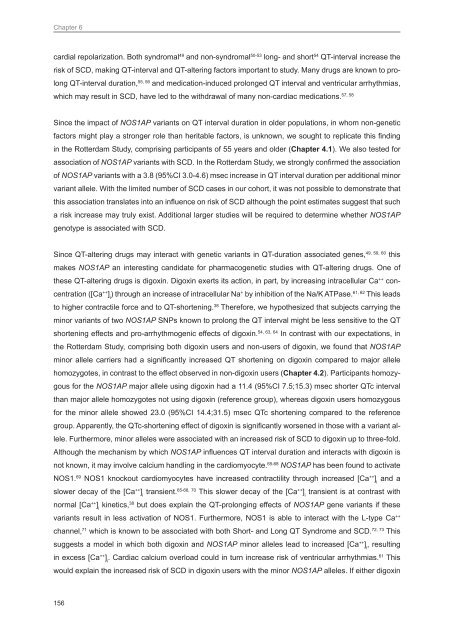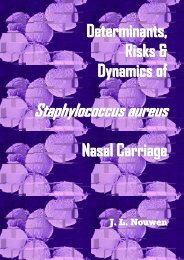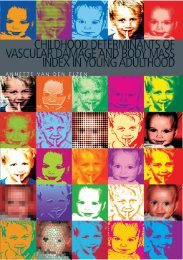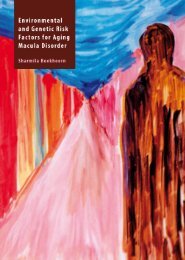Genetic susceptibility to adverse drug effects - Epidemiology ...
Genetic susceptibility to adverse drug effects - Epidemiology ...
Genetic susceptibility to adverse drug effects - Epidemiology ...
You also want an ePaper? Increase the reach of your titles
YUMPU automatically turns print PDFs into web optimized ePapers that Google loves.
Chapter 6<br />
cardial repolarization. Both syndromal 49 and non-syndromal 50-53 long- and short 54 QT-interval increase the<br />
risk of SCD, making QT-interval and QT-altering fac<strong>to</strong>rs important <strong>to</strong> study. Many <strong>drug</strong>s are known <strong>to</strong> prolong<br />
QT-interval duration, 55, 56 and medication-induced prolonged QT interval and ventricular arrhythmias,<br />
57, 58<br />
which may result in SCD, have led <strong>to</strong> the withdrawal of many non-cardiac medications.<br />
Since the impact of NOS1AP variants on QT interval duration in older populations, in whom non-genetic<br />
fac<strong>to</strong>rs might play a stronger role than heritable fac<strong>to</strong>rs, is unknown, we sought <strong>to</strong> replicate this finding<br />
in the Rotterdam Study, comprising participants of 55 years and older (Chapter 4.1). We also tested for<br />
association of NOS1AP variants with SCD. In the Rotterdam Study, we strongly confirmed the association<br />
of NOS1AP variants with a 3.8 (95%CI 3.0-4.6) msec increase in QT interval duration per additional minor<br />
variant allele. With the limited number of SCD cases in our cohort, it was not possible <strong>to</strong> demonstrate that<br />
this association translates in<strong>to</strong> an influence on risk of SCD although the point estimates suggest that such<br />
a risk increase may truly exist. Additional larger studies will be required <strong>to</strong> determine whether NOS1AP<br />
genotype is associated with SCD.<br />
Since QT-altering <strong>drug</strong>s may interact with genetic variants in QT-duration associated genes, 49, 59, 60 this<br />
makes NOS1AP an interesting candidate for pharmacogenetic studies with QT-altering <strong>drug</strong>s. One of<br />
these QT-altering <strong>drug</strong>s is digoxin. Digoxin exerts its action, in part, by increasing intracellular Ca ++ concentration<br />
([Ca ++ ] i<br />
) through an increase of intracellular Na + by inhibition of the Na/K ATPase. 61, 62 This leads<br />
<strong>to</strong> higher contractile force and <strong>to</strong> QT-shortening. 38 Therefore, we hypothesized that subjects carrying the<br />
minor variants of two NOS1AP SNPs known <strong>to</strong> prolong the QT interval might be less sensitive <strong>to</strong> the QT<br />
shortening <strong>effects</strong> and pro-arrhythmogenic <strong>effects</strong> of digoxin. 54, 63, 64 In contrast with our expectations, in<br />
the Rotterdam Study, comprising both digoxin users and non-users of digoxin, we found that NOS1AP<br />
minor allele carriers had a significantly increased QT shortening on digoxin compared <strong>to</strong> major allele<br />
homozygotes, in contrast <strong>to</strong> the effect observed in non-digoxin users (Chapter 4.2). Participants homozygous<br />
for the NOS1AP major allele using digoxin had a 11.4 (95%CI 7.5;15.3) msec shorter QTc interval<br />
than major allele homozygotes not using digoxin (reference group), whereas digoxin users homozygous<br />
for the minor allele showed 23.0 (95%CI 14.4;31.5) msec QTc shortening compared <strong>to</strong> the reference<br />
group. Apparently, the QTc-shortening effect of digoxin is significantly worsened in those with a variant allele.<br />
Furthermore, minor alleles were associated with an increased risk of SCD <strong>to</strong> digoxin up <strong>to</strong> three-fold.<br />
Although the mechanism by which NOS1AP influences QT interval duration and interacts with digoxin is<br />
not known, it may involve calcium handling in the cardiomyocyte. 65-68 NOS1AP has been found <strong>to</strong> activate<br />
NOS1. 69 NOS1 knockout cardiomyocytes have increased contractility through increased [Ca ++ ] i<br />
and a<br />
slower decay of the [Ca ++ ] i<br />
transient. 65-68, 70 This slower decay of the [Ca ++ ] i<br />
transient is at contrast with<br />
normal [Ca ++ ] i<br />
kinetics, 38 but does explain the QT-prolonging <strong>effects</strong> of NOS1AP gene variants if these<br />
variants result in less activation of NOS1. Furthermore, NOS1 is able <strong>to</strong> interact with the L-type Ca ++<br />
channel, 71 which is known <strong>to</strong> be associated with both Short- and Long QT Syndrome and SCD. 72, 73 This<br />
suggests a model in which both digoxin and NOS1AP minor alleles lead <strong>to</strong> increased [Ca ++ ] i<br />
, resulting<br />
in excess [Ca ++ ] i<br />
. Cardiac calcium overload could in turn increase risk of ventricular arrhythmias. 61 This<br />
would explain the increased risk of SCD in digoxin users with the minor NOS1AP alleles. If either digoxin<br />
156









